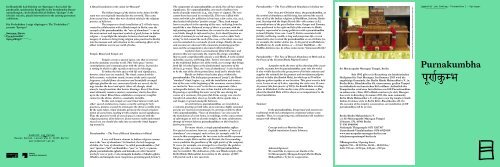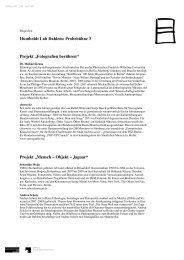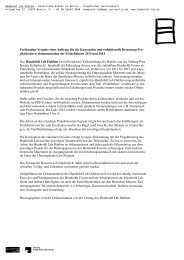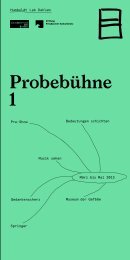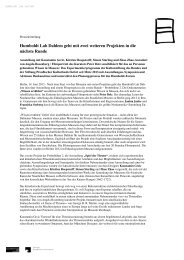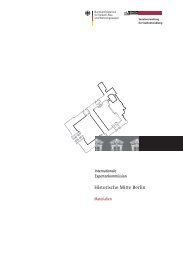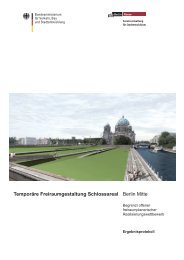Purnakumbha - Humboldt Forum
Purnakumbha - Humboldt Forum
Purnakumbha - Humboldt Forum
Erfolgreiche ePaper selbst erstellen
Machen Sie aus Ihren PDF Publikationen ein blätterbares Flipbook mit unserer einzigartigen Google optimierten e-Paper Software.
Im <strong>Humboldt</strong> Lab Dahlem ist »Springer« das Label für<br />
punktuelle, spielerische Eingriffe in die bestehenden Dauerausstellungen.<br />
/ At the <strong>Humboldt</strong> Lab Dahlem, “Springer” is the<br />
label for selective, playful interventions in the existing permanent<br />
exhibitions.<br />
Die Probebühne 1 zeigt »Springer« / The “Probebühne 1“<br />
presents “Springer“:<br />
Surinam / Benin<br />
<strong>Purnakumbha</strong><br />
Spiegelkugel<br />
<strong>Humboldt</strong> Lab Dahlem<br />
Museen Dahlem , Lansstraße 8, 14195 Berlin<br />
www.humboldt-lab.de<br />
A Ritual Installation in the Asian Art Museum?<br />
The Indian images of the deities in the Asian Art Museum<br />
were not originally intended for the art world. They come<br />
from sacred sites, where they were destined solely for the religious<br />
practice of believers.<br />
The temporary ritual installation of 2 + 8 holy vases,<br />
created in collaboration with a Hindu temple in Berlin, uses the<br />
example of the purnakumbha, the “vase of abundance” — one of<br />
the most ancient and important symbols of good fortune in Indian<br />
religion — to spotlight the interplay between ritual and temple<br />
imagery. It wishes to bring living religion (also practiced in Berlin)<br />
into the museum and call attention to the continuing effects of its<br />
oldest traditions even in our world of today.<br />
Temple, Ritual and Temple Art<br />
Temples create a special space, one that is removed<br />
from the mundane everyday world. This “holy space” invites<br />
contemplation and communication with the divine. It provides<br />
a setting in which to offer sacrifices and receive blessings.<br />
To imbue the holy space with life and significance,<br />
however, ritual acts are required. The ritual creates festivity:<br />
bells resonate, recitations sound, incense sticks emit a special<br />
fragrance, colorful flower decorations and beautifully arranged<br />
offerings gladden the eye, consecrated foods are served, the liturgy<br />
touches the heart and spirit. Above all, though, ritual<br />
aims for transformations that bestow blessings. Even if the divine<br />
must ultimately remain a mystery, momentary clarity does flare<br />
up in the ritual. Ritual thus establishes a temporary tangible<br />
contact to the divine, which is, essentially, invisible.<br />
To this end, temple art and ritual interact with each<br />
other: sacred architecture creates a worthy setting for holy<br />
practices, pictures created by artists give the divine a visible form.<br />
By the same token, ritual elements permeate the visual ornamentation<br />
of sacred sites, loading it with complex sacred significance.<br />
Thus the pictorial world of sacred spaces connects with the<br />
religious practice of its believers. If one wants to really understand<br />
sacred art, one should also take into account the ritual happening<br />
around it.<br />
<strong>Purnakumbha</strong> — The Vase of Blessed Abundance in Ritual<br />
A very well known element in Indian religious ceremonies<br />
is the “vase of abundance”. In Sanskrit, the holy language<br />
of India, the “vase of abundance” is called purnakumbha = “full<br />
vase” (purna = “full” and kumbha = “vase” or “pot”), or purnaghata,<br />
purnakalasha (ghata and kalasha are other Sanskrit<br />
words for vase or pot), or also mangala kalasha or bhadra ghata<br />
(bhadra and mangala mean “auspicious, promising good fortune”).<br />
The components of a purnakumbha are fixed, they all have deeper<br />
significance. For a purnakumbha, one needs a bulbous vase<br />
made of specific materials (e. g., clay, brass or copper). The vase<br />
cannot have been used in everyday life. This vase is filled with<br />
water and with a few additions (a betel nut, a few coins, rice, etc.),<br />
thus loaded with further “positive energy”. Then, fresh mango<br />
leaves are placed in the opening of the vase, radiating from the<br />
mouth like a star. Balanced on top of this is a coconut, with the<br />
tuft pointing upward. Sometimes, the coconut is also covered with<br />
a red cloth, though its tuft must be free, for it should function as<br />
a kind of antenna for sacred energy. Often, a red or white “holy<br />
string” is tied around the neck of the vase, or the whole vase may<br />
even be enmeshed in a net made of such strings. Finally, the vase<br />
and coconut are adorned with ornaments promising good fortune<br />
and the arrangement is decorated with fresh flowers.<br />
A pitcher that is ceremoniously filled with water and<br />
plants in this way represents the creative life energy, something<br />
that is easily comprehensible also for a non-Hindu. It is the symbol<br />
of fertility, success, well-being, bliss. Yet it is even more: according<br />
to the traditional Indian view of the world, every energy that brings<br />
forth life is looked upon as the fundamental expression of the<br />
divine (e. g. water). Thus, the “vase of abundance” is also believed<br />
to be the seat of the divine primal force itself and is thereby holy.<br />
Hardly an Indian ritual takes place without the<br />
purnakumbha. The daily puja (pronounced “pooja”), the Hindu<br />
“standard” ritual, begins, e. g., with the installation and invocation<br />
of the vase: at the beginning of the ceremony, various deities<br />
are invited to ”have a seat” in its diverse components. Like a<br />
rechargeable battery, the vase is thus loaded with divine energy.<br />
By pouring or sprinkling the water out of the vase during the<br />
course of a ceremony, this powerful divine energy can even be<br />
transferred somewhere else (e. g., breathe divine sparks into a<br />
cult image) or spread among the believers.<br />
At celebrations, purnakumbhas are installed as<br />
a welcome greeting on both sides of an entrance; highly esteemed<br />
persons are received ceremoniously, by carrying a tablet to them<br />
with a purnakumbha. “Vases of abundance” are also used in<br />
the benediction of a new home, in weddings, in the consecration<br />
of cult images as well as of entire temples. At some celebrations,<br />
throngs of women balance purnakumbhas on their heads in<br />
festive procession.<br />
For many rituals, a single purnakumbha suffices.<br />
For special occasions, however, a specific number of “vases of<br />
abundance” are arranged, such as here, for example, with 2 + 8<br />
vases (in this arrangement, the two vases in the middle represent<br />
the divine couple Shiva and his wife Parvati, the 8 surrounding<br />
vases symbolize the guardians of the eight points of the compass).<br />
51 vases, for example, are arranged in a ritual for the goddess<br />
Durga, for other occasions, 108 or even 1008 purnakumbhas<br />
may be installed. The dedication of the new Hindu temple of the<br />
Berlin Hindu Mahasabhai Association in the summer of 2013<br />
will provide such a rare spectacle.<br />
<strong>Purnakumbha</strong> — The Vase of Blessed Abundance in Indian Art<br />
Ever since pre-Christian times, the purnakumbha, as<br />
the symbol of abundance and blessing, has adorned the sacred<br />
sites of all of the Indian religions (of Buddhism, Jainism, Hinduism).<br />
Starting with the Gupta Period (4th — 6th century A. D.),<br />
personifications of the great Indian rivers, Ganges and Yamuna,<br />
were positioned to the right and left of the entrance to Hindu<br />
temples, represented as young goddesses with a purnakumbha<br />
in hand (Display Case: nos. 1 and 5). Deities associated with<br />
fertility, well-being, wealth, a long and prosperous life, or even<br />
immortality also received the purnakumbha as an attribute (as,<br />
for example, the mother deities (no. 3), the god of wealth Kubera /<br />
Jambhala (no. 2), snake deities, or — in later Buddhism — the<br />
Buddha Amitayus (no. 4), whose name means “immeasurable life”.<br />
<strong>Purnakumbha</strong> — The Vase of Blessed Abundance in Myth and as<br />
the Focus of the Greatest Hindu Pilgrim Festival<br />
A popular myth, the story of the churning of the ocean<br />
of milk, recounts how the purnakumbha came into the world.<br />
It also vividly describes the great power of its holy contents and<br />
supplies the rationale for the greatest and most famous pilgrim<br />
festival in India (the Kumbh Mela), for which up to 70 million<br />
pilgrims gather together at one location. This great event is held<br />
every 3 years at one of 4 sites, repeating the cycle every 12 years.<br />
At present (the first quarter of 2013), the Kumbh Mela is taking<br />
place in Allahabad. In the media room of the museum, a film<br />
about the Kumbh Mela will be shown as accompaniment to the<br />
ritual installation.<br />
Summary<br />
In the purnakumbha, living ritual and ancient art,<br />
traditional myth and contemporary ceremonial culture come<br />
together. Thus, in a surprising way, millenniums-old tradition<br />
merges with vibrant life.<br />
Concept and text: Martina Stoye<br />
English translation: Laurie Schwartz<br />
Acknowledgement:<br />
We would like to express our thanks to the<br />
Sri Mayurapathy Murugan-Tempel (Berlin Hindu<br />
Mahasabhai e. V.) for its cooperation.<br />
Sri Mayurapathy Murugan Tempel, Berlin<br />
Seit 1992 gibt es in Kreuzberg ein hinduistisches<br />
Heiligtum für Gott Murugan. Im Sommer 2013 wird die<br />
zugehörige Gemeinde, der Berlin Hindu Mahasabhai e. V., in<br />
Berlin-Britz, Blaschkoallee 48, einen neuen, großen Tempel<br />
im südindisch-ceylonesischen Stil eröffnen. Anlässlich der<br />
Tempelweihe wird eine Installation von 108 <strong>Purnakumbha</strong>s<br />
zu sehen sein. / Since 1992 a Hindu sanctuary for deity Murugan<br />
does exist in Kreuzberg. In summer 2013, this same community,<br />
Berlin Hindu Mahasabhai e. V., will open a new big temple in South<br />
Indian-Ceylonese style in Berlin Britz, Blaschkoallee 48. On<br />
the occasion of the temple’s consecration, an installation of 108<br />
purnakumbhas will be on view.<br />
Berlin Hindu Mahasabhai e. V.<br />
c/o Sri Mayurapathy Murugan Tempel<br />
Urbanstr. 176, 10961 Berlin<br />
T: 030 6946900<br />
Nadarajah Thiagarajah: 0171 5267307<br />
Umayakanth Vimalakanthan: 0176 65120119<br />
www.mayurapathy-murugan-berlin.com<br />
info@murugantempel-berlin.de<br />
Öffnungszeiten / Opening hours:<br />
täglich 7:30 — 12:30 Uhr, 16:30 — 19:30 Uhr /<br />
daily 7:30 am — 12:30 pm, 4:30 pm — 7:30 pm<br />
Holz-Modell des noch im Bau befindlichen Berliner Murugan-Tempels (Foto: Rolf Sailer)<br />
<strong>Humboldt</strong> Lab Dahlem — Probebühne 1 — Springer<br />
<strong>Purnakumbha</strong>
Die indische Vase des Überflusses —<br />
eine hinduistische Ritualinstallation<br />
in 2 + 8 Töpfen<br />
Die indischen Götterbilder des Museums für<br />
Asiatische Kunst waren ursprünglich nicht für den Kunstbetrieb<br />
gedacht. Sie stammen aus Heiligtümern, waren dort<br />
allein für die religiöse Praxis von Gläubigen bestimmt. Die<br />
temporäre Ritual-Installation von 2 + 8 heiligen Töpfen, in<br />
Zusammenarbeit mit einem Hindutempel in Berlin erstellt,<br />
möchte am Beispiel des »<strong>Purnakumbha</strong>«, der Vase des<br />
Überflusses — einem der wichtigsten und ältesten Glück<br />
verheißenden Symbole indischer Religion — ein Schlaglicht<br />
auf die Wechselwirkung von Ritual und Bildsprache werfen.<br />
Sie möchte die (auch in Berlin praktizierte) lebendige<br />
Religion ins Museum holen und auf das Fortwirken ihrer<br />
ältesten Traditionen bis in unsere Gegenwart hinweisen.<br />
Flussgöttin Yamuna; Indien; 10. Jh. n. Chr.; Museum für Asiatische Kunst Berlin Inv.-Nr. 10101 © Museum für Asiatische Kunst, SMB-SPK,<br />
Foto: Iris Papadopoulos<br />
Tempel, Ritual und Tempelkunst<br />
Tempel schaffen einen besonderen, aus der profanen<br />
Alltagswelt herausgehobenen Raum. Dieser »heilige<br />
Raum« lädt zu Kontemplation und Kommunikation mit dem<br />
Göttlichen ein. Er bietet einen Rahmen, um Opfergaben<br />
darzubringen und Segen zu empfangen.<br />
Um den heiligen Raum mit Leben und Gültigkeit<br />
zu erfüllen, bedarf es jedoch ritueller Handlungen. Das<br />
Ritual schafft Festlichkeit: Glocken erklingen, Rezitationen<br />
ertönen, Räucherstäbchen verströmen einen besonderen<br />
Duft, farbenfroher Blumenschmuck, schön arrangierte<br />
Opfergaben erfreuen das Auge, gesegnete Speisen werden<br />
gereicht, die Liturgie berührt Herz und Geist. Ritual zielt<br />
aber vor allem auf Segen spendende Transformationen ab.<br />
Auch wenn das Göttliche dabei letztendlich ein Mysterium<br />
bleiben muss, so blitzt im Ritual doch vorübergehend Anschaulichkeit<br />
auf. Das Ritual stellt also einen sinnlich erfahrbaren<br />
Kontakt zum eigentlich unsichtbaren Göttlichen her.<br />
Die Kunst des Tempels und das Tempelritual<br />
wirken zu diesem Zweck ineinander: Sakrale Architektur<br />
schafft einen würdigen Rahmen für heilige Handlungen,<br />
von Künstlern geschaffene Bilder geben dem Göttlichen eine<br />
sichtbare Gestalt. Umgekehrt durchdringen Ritualelemente<br />
den Bildschmuck der Heiligtümer, laden ihn mit komplexer<br />
sakraler Bedeutung auf. So verbindet sich die Bildwelt<br />
heiliger Räume mit der religiösen Praxis ihrer Gläubigen.<br />
Will man Sakralkunst wirklich verstehen, sollte man das<br />
um sie herum geschehende Ritual mit in den Blick nehmen.<br />
<strong>Purnakumbha</strong> — die Vase segenshafter<br />
Fülle im Ritual<br />
Ein sehr bekanntes Element im Zeremoniell indischer<br />
Religiosität ist die Vase des Überflusses. Auf Sanskrit,<br />
der heiligen Sprache Indiens, heißt die »Vase des Überflusses«<br />
purnakumbha = »Voller Topf« (purna = voll und<br />
kumbha = Topf), oder auch purnaghata, purnakalasha (ghata<br />
und kalasha sind andere Sanskritworte für Topf), oder auch<br />
mangala kalasha oder bhadra ghata (bhadra und mangala<br />
bedeuten »Glück verheißend«).<br />
Die Bestandteile eines <strong>Purnakumbha</strong> sind festgelegt,<br />
sie haben alle tiefere Bedeutung. Für einen <strong>Purnakumbha</strong><br />
benötigt man einen bauchigen Topf aus bestimmten<br />
Materialien (z. B. Ton, Messing oder Kupfer). Der Topf darf<br />
nicht im Alltag verwendet worden sein. Diese »Vase« wird mit<br />
Wasser gefüllt und durch einige Beigaben (eine Betelnuss,<br />
ein paar Münzen, Reis u. ä.) mit zusätzlicher »guter Energie«<br />
aufgeladen. Dann werden in die Vasenöffnung sternförmig<br />
frische Mangoblätter gelegt. Darauf wird eine Kokosnuss<br />
drapiert, mit dem Schopf nach oben. Manchmal wird die Kokosnuss<br />
noch mit einem roten Tuch umhüllt, ihr Schopf aber<br />
muss frei bleiben, denn er soll wie eine Art Antenne für heilige<br />
Energie wirken. Häufig wird abschließend eine rote oder<br />
weiße »heilige Schnur« um den Vasenhals gebunden oder<br />
sogar die ganze Vase mit einem Netz aus solchen Schnüren<br />
umgarnt. Schließlich werden Topf und Kokosnuss mit Glück<br />
verheißenden Ornamenten verziert. Zum Schluss wird das<br />
Arrangement mit frischen Blumen geschmückt.<br />
Ein so mit Wasser und Pflanzen festlich gefüllter<br />
Krug repräsentiert, auch für einen Nicht-Hindu gut nachvollziehbar,<br />
die kreative Lebensenergie. Er ist Sinnbild von<br />
Fruchtbarkeit, Gelingen, Wohlergehen, Segen. Doch er ist<br />
noch mehr: In der traditionellen indischen Weltanschauung<br />
wird jede Leben hervorbringende Energie als wesentlicher<br />
Ausdruck des Göttlichen angesehen (z. B. Wasser). So gilt die<br />
Vase des Überflusses auch als Sitz der göttlichen Urkraft<br />
selbst und ist damit heilig.<br />
Kaum ein indisches Ritual findet ohne den <strong>Purnakumbha</strong><br />
statt. Die tägliche Puja (sprich »Pudscha«), das<br />
hinduistische »Standard« ritual, beginnt beispielsweise<br />
mit Installation und Anrufung des Topfes: Am Anfang der<br />
Zeremonie lädt man verschiedene Gottheiten ein, in seinen<br />
diversen Bestandteilen »Platz zu nehmen«. Einem Akku<br />
gleich wird der Topf so mit göttlicher Energie aufgeladen.<br />
Durch Ausgießen oder Versprengen des Wassers aus dem<br />
Topf kann man im Laufe einer Zeremonie diese kraftvolle<br />
göttliche Energie schließlich sogar anderswohin übertragen<br />
(z. B. einem Kultbild göttlichen Funken einhauchen) oder<br />
auch an Gläubige verteilen.<br />
Bei Festen werden <strong>Purnakumbha</strong>s als Begrüßung<br />
zu beiden Seiten eines Eingangs aufgestellt; hochgeschätzte<br />
Personen empfängt man feierlich, indem man Ihnen<br />
ein Tablett mit einem <strong>Purnakumbha</strong> entgegenträgt. Vasen<br />
des Überflusses kommen auch bei der Weihe eines neuen<br />
Hauses zum Einsatz, bei Hochzeiten, bei der Weihe von<br />
Kultbildern sowie von ganzen Tempeln. Bei einigen Festen<br />
balancieren Scharen von Frauen in feierlicher Prozession<br />
<strong>Purnakumbha</strong>s auf dem Kopf.<br />
Für viele Rituale genügt ein einziger <strong>Purnakumbha</strong>.<br />
Bei besonderen Gelegenheiten arrangiert man<br />
jedoch eine bestimmte Zahl von Vasen des Überflusses,<br />
z. B. wie hier: 2 + 8 Töpfe (dabei stellen die beiden mittleren<br />
Töpfe das Götterpaar Shiva und seine Frau Parvati dar,<br />
die 8 umgebenden Töpfe versinnbildlichen die Hüter der<br />
acht Himmelsrichtungen). 51 Vasen arrangiert man in<br />
einem Ritual für die Göttin Durga, zu anderen Gelegenheiten<br />
werden 108 oder gar 1008 <strong>Purnakumbha</strong>s installiert.<br />
Die Einweihung des neuen Hindutempels des Berlin Hindu<br />
Mahasabhai e. V. im Sommer 2013 wird ein solch seltenes<br />
Schauspiel bieten.<br />
<strong>Purnakumbha</strong> — die Vase segenshafter<br />
Fülle in der indischen Kunst<br />
Schon seit vorchristlicher Zeit schmückte der <strong>Purnakumbha</strong><br />
als Fülle und Segen verheißendes Symbol Heiligtümer<br />
aller indischen Religionen (des Buddhismus, Jainismus,<br />
Hinduismus). Ab der Gupta-Zeit (4. — 6. Jh. n. Chr.)<br />
wurden Personifikationen der großen indischen Flüsse,<br />
Ganges und Yamuna, rechts und links der Eingangstür von<br />
Hindu-Tempeln platziert, dargestellt als junge Göttinnen<br />
mit <strong>Purnakumbha</strong> in der Hand (in der Vitrine: Nr. 1 und 5).<br />
Auch andere mit Fruchtbarkeit, Wohlergehen, Reichtum,<br />
langem, blühendem Leben oder gar Unsterblichkeit verbundene<br />
Gottheiten bekamen den <strong>Purnakumbha</strong> als Attribut<br />
(so z. B. Muttergottheiten (Vitrine: Nr. 3), der Reichtumsgott<br />
Kubera / Jambhala (Vitrine: Nr. 2), Schlangengottheiten, oder<br />
— im späteren Buddhismus — der Buddha Amitayus (Vitrine:<br />
Nr. 4), dessen Name »unermessliches Leben« bedeutet.<br />
<strong>Purnakumbha</strong> — die Vase segenshafter<br />
Fülle im Mythos und als Fokus des größten<br />
hinduistischen Pilgerfestes<br />
Ein bekannter Mythos, die Geschichte von der<br />
Quirlung des Milchozeans, erzählt, wie der <strong>Purnakumbha</strong><br />
in die Welt kam. Er schildert auch anschaulich die große<br />
Wirkkraft seines heiligen Inhalts und liefert die Begründung<br />
für das größte und berühmteste Pilgerfest Indiens,<br />
die Kumbha Mela, bei dem sich bis zu 70 Millionen Pilger<br />
an einem Ort versammeln. Nur alle 12 Jahre kommt es zu<br />
diesem großen Ereignis.<br />
<strong>Purnakumbha</strong> im Ritual (Foto: Silke Blumbach)<br />
Derzeit (im ersten Quartal 2013) findet die Kumbha Mela in<br />
Allahabad statt. Im Medienraum des Museums wird begleitend<br />
zur Ritual-Installation ein Film über die Kumbha<br />
Mela gezeigt.<br />
Fazit<br />
Im <strong>Purnakumbha</strong> treffen sich lebendiges Ritual<br />
und alte Kunst, lang überlieferter Mythos und Festkultur<br />
der Gegenwart. So verbinden sich, auf überraschende Weise,<br />
jahrtausendealte Überlieferung mit pulsierendem Leben.<br />
Konzept und Text: Martina Stoye<br />
Danksagung:<br />
Wir danken dem Sri Mayurapathy Murugan-<br />
Tempel (Berlin Hindu Mahasabhai e. V.) für die<br />
Zusammenarbeit.<br />
Priester mit <strong>Purnakumbha</strong> bei Bildweihe in einem Berliner Tempel (Foto: Brigitte Luchesi)


